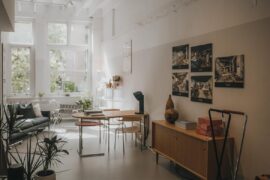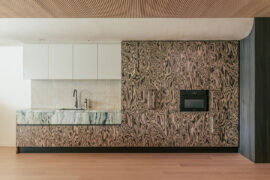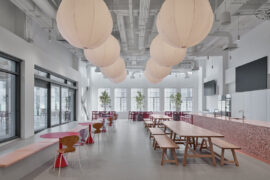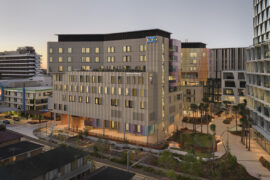Creating a soothing workplace environment is continuing to move up as a desired requirement on client briefs. This project considers workplace wellness in an all-new way.
November 5th, 2019
In 2019, an office is no longer simply a space to work. It is a drawcard, a content platform and, in the case of Energy and Water Ombudsman Victoria’s new Melbourne headquarters, a sanctuary. And it’s no wonder: the not-for-profit organisation functions in part as an impartial dispute resolution service. High numbers of complaints from disgruntled customers creates an emotionally-taxing work environment. The challenge for WMK Architecture was to use design as an antidote, which it sought to do by making the mental wellbeing of Energy and Water Ombudsman Victoria’s (EWOV) employees its key consideration.
But WMK’s design for EWOV’s entire floor of Melbourne Central Tower does not look like the typically minimalistic, muted interior style that’s become emblematic of the contemporary ‘wellbeing’ aesthetic. Aside from a generous peppering of greenery, the Melbourne arm of WMK’s practice has rejected those expected visual cues, instead drawing upon a concept altogether more unexpected: ‘a tranquil river walk in the Australian landscape.’
To realise this vision, WMK harnessed the full colour spectrum of Australia’s natural world to evoke feelings of calm and warmth. A neutral canvas of mineral greys and timber offsets tones of sea-foam green and red earth in a confident display of native influences. A redesign of the floor plan allows for more haphazard interaction between staff, where a mottled blue pathway leads teams through various zones; a flowing tributary encouraging seamless collaboration and communication.
At the heart of the space, a main hub is delineated by timber floorboards and is split into two sections: one elevated onto a modest platform. Within this central zone, large ocean-blue pods in spherical frames offer up playful, safe havens for small groups. A generous conference room with fully retractable doors offers both literal and metaphorical openness. Opposite, smaller meeting rooms suggest a more intimate and flexible workspace dynamic.
It’s here in this hub that WMK’s use of a rich shade of burnt clay is fully realised, subtly injected in the framework of glass walls as well as in the gauzy curtains that gently shield those behind them. At the perimeters of the space, overlooking a bustling cityscape below, staff are encouraged to pause on soft lounge chairs in sunset tones of peach and grey.
WMK’s strategy to counteract a highly-charged atmosphere relied on equal parts function and beauty. It’s the tactics its designers employed that highlights how far workplace design has evolved in recent years, showcasing a leap into a realm that takes conceptual themes and abstract references to create spaces that are delightful – even literal – expressions of an organisation’s purpose. At EWOV, vibrant material selection and deft spatial planning has resulted in a clever, fluid office that honours the role at the company’s heart. More than this, EWOV’s new home captures the thing that is central to all strong human-driven design outcomes: a clear vision that puts people at its core.
We think you’ll enjoy this thought piece about workplaces as high-performing sanctuaries. Never miss a beat, join our mailing list for all the latest inspiration.
INDESIGN is on instagram
Follow @indesignlive
A searchable and comprehensive guide for specifying leading products and their suppliers
Keep up to date with the latest and greatest from our industry BFF's!

Rising above the new Sydney Metro Gadigal Station on Pitt Street, Investa’s Parkline Place is redefining the office property aesthetic.

Sydney’s newest design concept store, HOW WE LIVE, explores the overlap between home and workplace – with a Surry Hills pop-up from Friday 28th November.

London-based design duo Raw Edges have joined forces with Established & Sons and Tongue & Groove to introduce Wall to Wall – a hand-stained, “living collection” that transforms parquet flooring into a canvas of colour, pattern, and possibility.

Merging two hotel identities in one landmark development, Hotel Indigo and Holiday Inn Little Collins capture the spirit of Melbourne through Buchan’s narrative-driven design – elevated by GROHE’s signature craftsmanship.

Trust sits at the core of Everton Buildings’ new office, where Ambit Curator was given licence to move beyond convention and deliver a workplace defined by vision, materiality and assured detail.

The new headquarters for Omnicom in Melbourne’s CBD sees heritage re-invigorated with style and finesse.
The internet never sleeps! Here's the stuff you might have missed

BLP’s new Sydney Children’s Hospital, Randwick building brings together paediatric care, family-centred design and Australia’s first Children’s Comprehensive Cancer Centre in a major addition to the Randwick Health & Innovation Precinct.

Former INDE Luminary LeAmon joins the Design Institute of Australia (DIA) following more than a decade as the inaugural Curator of Contemporary Design and Architecture at the National Gallery of Victoria (NGV).